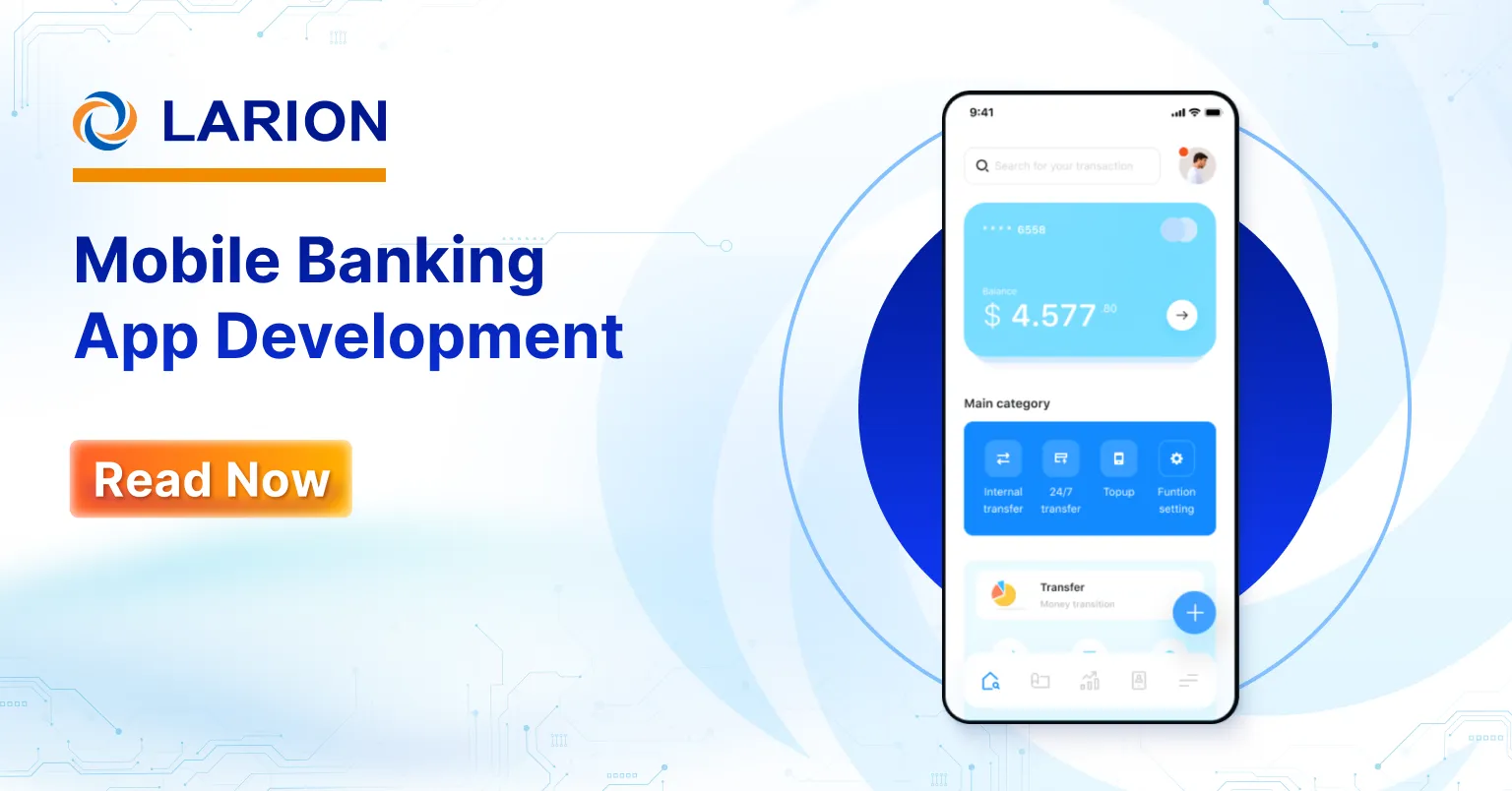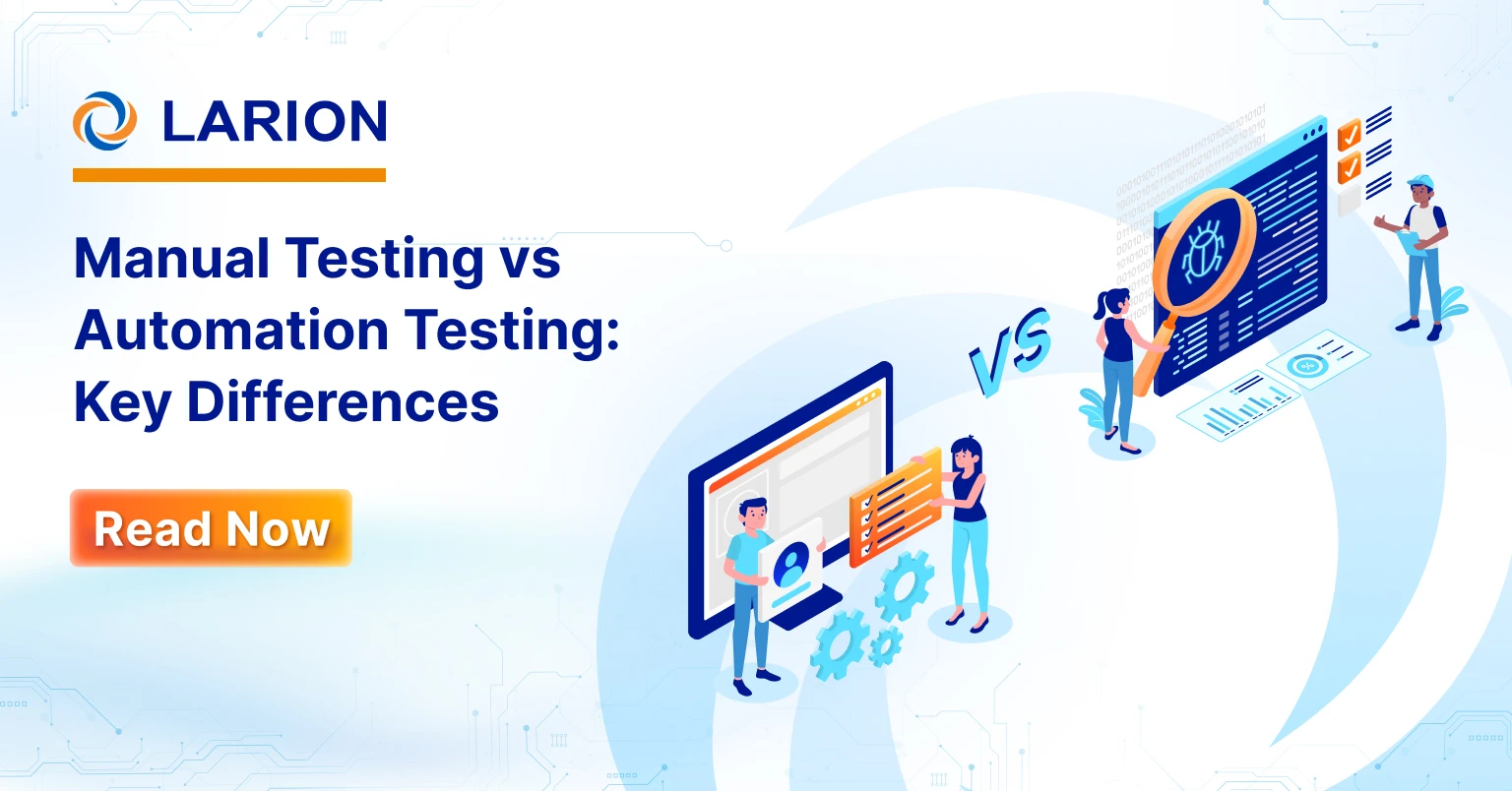
Many mobile apps fail not because of a lack of great ideas, but because of poor architectural planning. Without the right foundation, apps become hard to scale, difficult to maintain, and prone to crashes and performance issues.
Imagine investing months—or even years—into building an app, only to see it struggle with frequent bugs, slow updates, and frustrated users abandoning it. Poor architecture doesn’t just slow you down; it can seriously damage your app’s reputation and your business growth.
That’s why a strong mobile app architecture is crucial. With a solid, scalable foundation, your app becomes more reliable, easier to update, and ready to grow with your users. In this guide, we’ll break down the essentials of mobile app architecture and show you how to set your app up for long-term success.
What Is Mobile App Architecture?
Much like a building needs a strong foundation, a mobile app needs a well-defined architecture.
The architecture defines an app’s rules, processes, and internal structure to dictates how components (e.g. front-end UI, backend database, APIs, etc.) interact to process inputs and deliver outputs to users
How Mobile App Architecture Different from Mobile App Tech Stack
While closely related, app architecture and tech stack are not the same. A tech stack refers to the collection of technologies and tools used to develop an app, including programming languages, third-party plugins, and hardware platforms. In contrast, architecture focuses on how these technologies are structured and integrated within the app.
Beyond just tools, architecture also encompasses other critical aspects, such as data flow and user interactions.
In short, the tech stack is just one element of a mobile app’s overall architecture
What Are the Different Layers in Mobile App Architecture?
A mobile app architecture typically consists of three layers—each with a specific responsibility. Understanding these layers is essential for making informed decisions about your mobile app’s development.
For you to better understand how these layers tie together, take a look at the mobile app architecture diagram below:
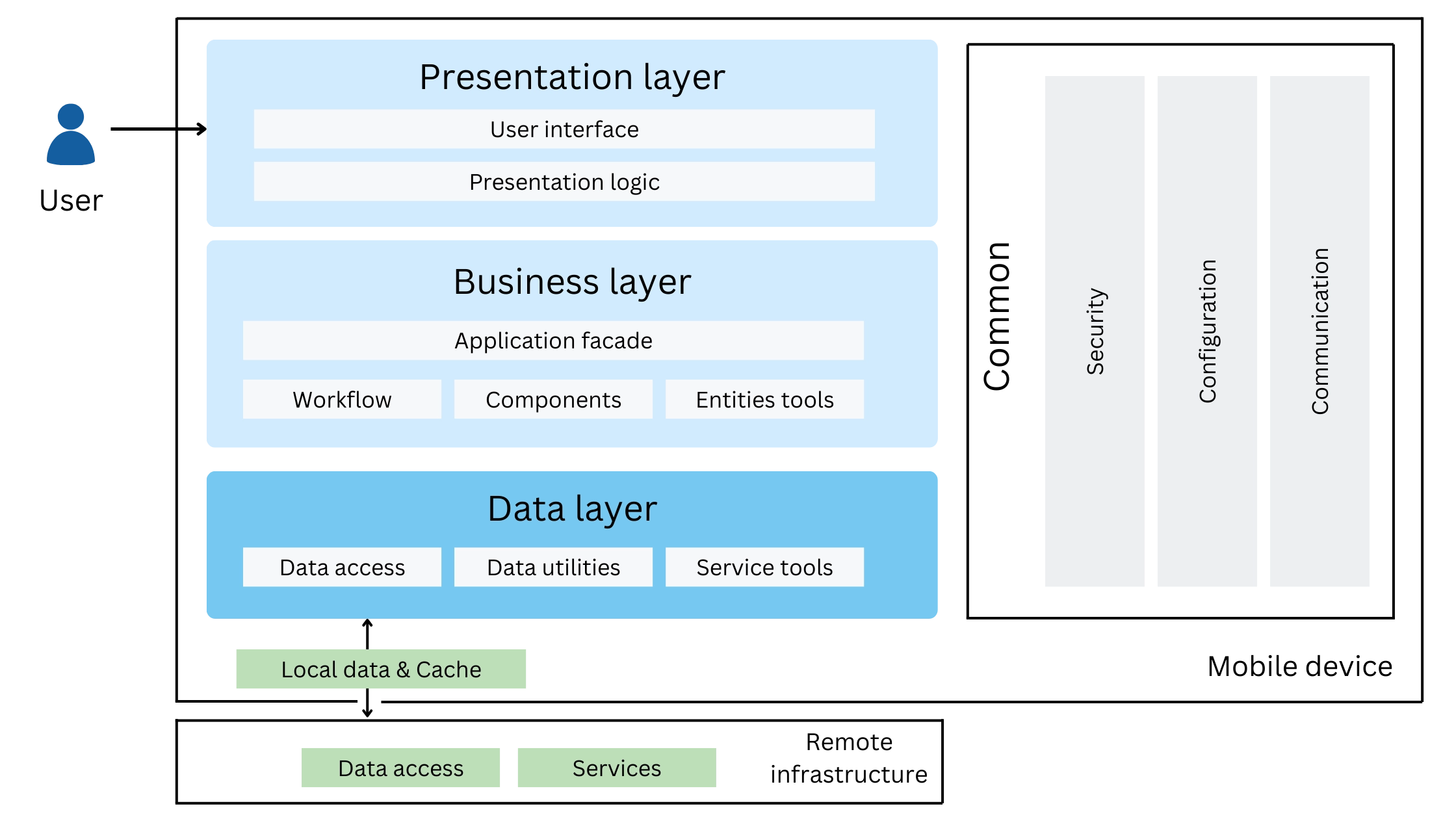
Presentation layer (UI/UX)
The presentation layer is the face of your mobile app. It’s what your users see and interact with. Its primary function is to receive data from the business layer then present information to the user and receive their input. A well-designed presentation layer is intuitive, user-friendly, and visually appealing.
For instance, in a mobile banking app, it might take transaction history data and present it as an interactive spending chart, giving users a visual breakdown of their expenses over time.

Business layer
Sitting between the presentation and data layers is the business layer. This mobile application architecture layer contains the core logic and rules that govern how your app operates. It typically processes user input or raw data received from the data layer, then sends the refined results to the presentation layer.
For example, in a mobile banking app, when a user initiates a funds transfer, the business layer handles the logic—verifying account details, checking for sufficient balance, applying transfer rules, and processing the transaction.
Once completed, the result is passed to the user interface for display.

This layer is often the most complex part of the application. It’s usually broken down into several sublayers or components, each responsible for specific business functions.
It’s also important to note that the business layer doesn’t always reside within the user’s app. In many cases, part or even all of it can be hosted on the server, with the app primarily serving as the user interface.
Data layer
The data layer serves as a bridge between the application’s other layers and external resources.
Its primary role is to retrieve raw data from sources like databases, cloud servers, or APIs and deliver it to the upper layers—and send processed data back when needed.
For instance, if a user wants to view their profile, the data layer fetches the relevant information—such as name, birthdate, and profile photo—from the database.
At this stage, the data is still unprocessed and may include elements like internal tags or IDs that aren’t meant for user display. It’s the business layer’s job to clean and prepare this data for presentation.
Because raw data is highly sensitive and vulnerable, strong security measures are essential at the data layer. Additionally, maintaining proper data separation from different sources is crucial, as combining them is considered poor practice.
Types of Mobile App Architecture
We’ve talked about the layers that make up a mobile app (Presentation, Business, and Data layers). But how you organize those layers matter just as much. That’s where the type of mobile app architecture comes in.
Let’s take a look at the three major types of mobile application architecture:
Layered architecture (N-Tier)
Layered or N-tier architecture involves grouping components with similar functions and organizing them into distinct layers or tiers. This architecture is commonly used in on-premise software solutions.
Typically, N-tier applications include three core layers: data, business (or application), and presentation. However, depending on the complexity and requirements, some applications may have more than 3 layered architectures.
This modularity is a huge advantage. In layered architecture, each layer can only communicate with the one directly above or below it. This principle is crucial for managing dependencies and maintaining security.
For instance, the client layer isn’t allowed to interact directly with the data layer, as that could pose security risks.
Instead, data requests must go through the business and integration layers, which handle validations and security controls.
Also, it means that you can update one layer without necessarily affecting the others. It’s like renovating just one room without tearing down the whole building.
While N-layered architecture is relatively straightforward and easy to maintain in smaller systems, it can become challenging in larger applications. Diagnosing issues often requires checking multiple layers to trace the source of an error.
Monolithic architecture
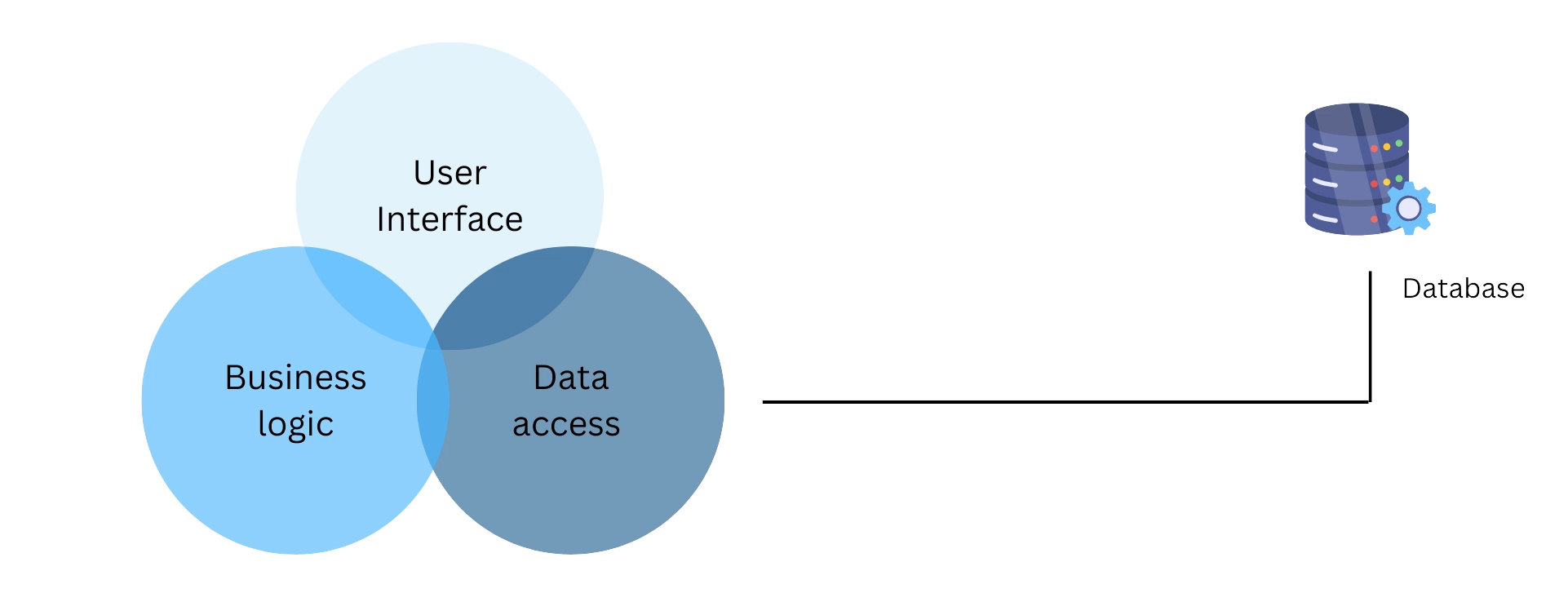
A monolithic architecture builds your app as a single, unified block. All the core layers and any other components are tightly coupled together within one codebase. Because of that, it can be faster to get your mobile app up and running initially. This type of mobile application architecture is perfect for smaller, minimalist apps.
However, it’s important to recognize the limitations of monolithic architecture as your app grows. Yes, it’s suitable for smaller projects, but for larger and more complex apps, monolithic architecture can become a bottleneck. If there’s a need to upgrade or update your app, it follows that you need to edit the codebase. In doing so, you’ll need to revisit the entirety of it since you only have a unified codebase. That’s more challenging and time-consuming.
Microservices architecture
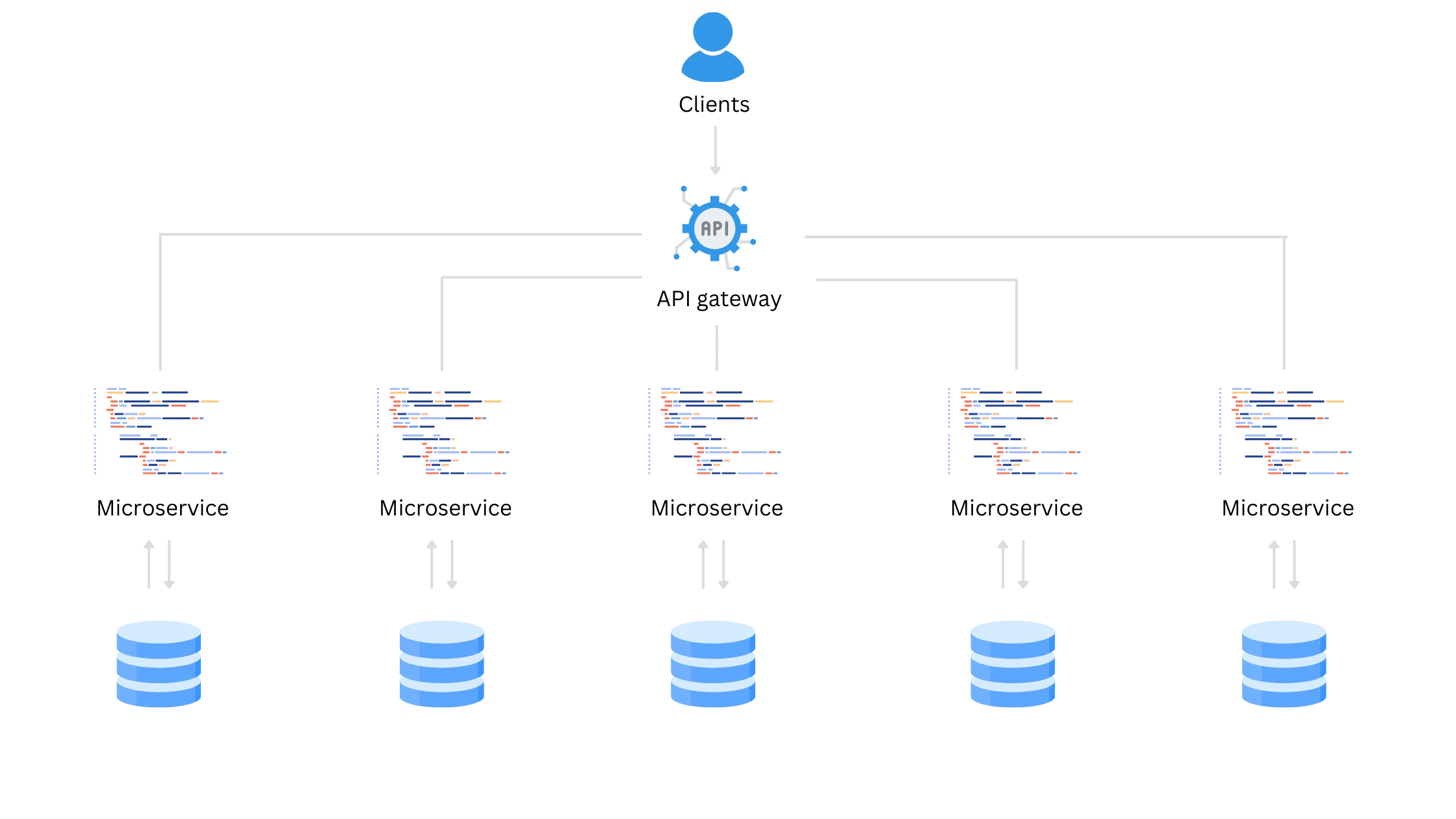
Microservices architecture breaks the application down into smaller, independent components known as microservices.
Each microservice operates on its own and doesn’t rely on other components to function.
The main client application interacts with these microservices through an application programming interface (API), as illustrated below:
Let’s use an analogy to understand further how it works. Think of a large office building made up of smaller interconnected departments—one for accounting, one for marketing, etc. Each department can function independently, be updated separately, and scaled as needed. That’s how microservices architecture works. Each microservice is like a specialized department within your app.
This is the kind of architecture used by large, complex apps like Uber, Netflix, and Amazon. These apps handle massive amounts of data, traffic, and constantly evolving features. Microservices allow them to adapt quickly, scale efficiently, and maintain high availability. If you’re aiming for a mobile app that’s built for long-term growth, microservices might be the right choice.
One major drawback of microservices architecture is the complexity of deployment, as each microservice needs to be deployed individually. This becomes increasingly challenging as the application grows in size.
Despite this, microservices remain the preferred approach for building complex cloud-based and hybrid applications
UI Architecture Patterns
When we talk about architecture of mobile apps, we also put special emphasis on the presentation layer. As this layer alone is a broad and complex subject, there are also best practices and patterns developers rely on to build mobile apps.
Let’s explore the three most common UI architecture patterns:
| MVC | MVVM | MVP | |
| Intermediary | Controller | ViewModel | Presenter |
| View Interaction | Directly interacts with Model | Binds to ViewModel | Updated by Presenter |
| Testability | Moderate | High (ViewModel testable) | High (View passive, Presenter testable) |
| Use Cases | Web apps, simpler UIs | Complex UIs, data binding | Test-driven development, complex logic |
Model-View-Controller (MVC)
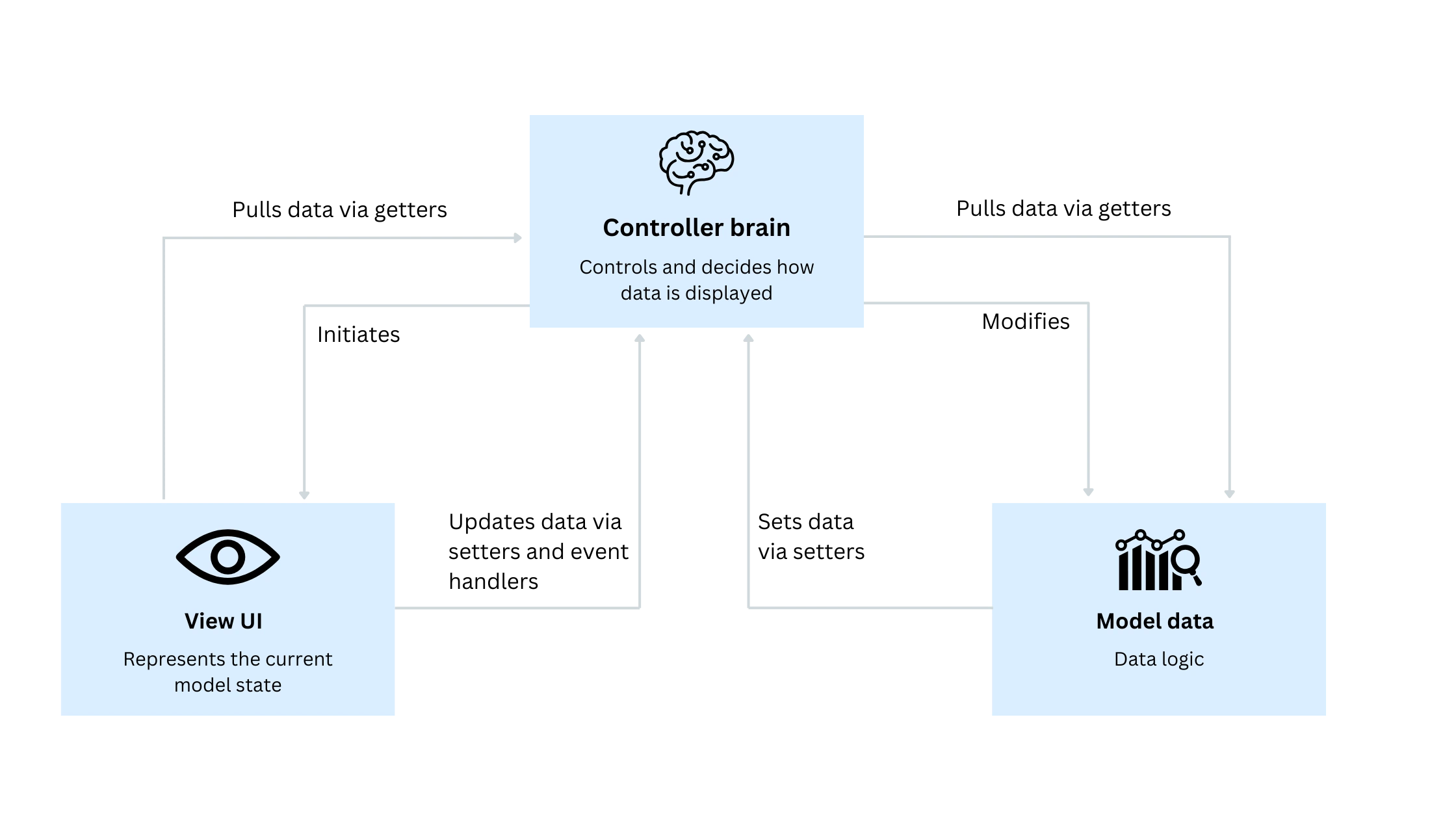
MVC is a well-established UI architecture pattern. It organizes the presentation layer into three interconnected components: Model, View, and Controller. The Controller acts as the go-between, managing user interactions (like button clicks) and updating the Model (your app’s data). The View is more active in MVC, meaning it can directly access the Model to get the data it needs to display. This makes MVC a suitable choice for web apps and applications with less complex user interfaces.
Model-View-ViewModel (MVVM)

MVVM is another popular UI architecture pattern, especially in modern mobile and desktop development. It also uses a Model and a View, but the key component is the ViewModel. The ViewModel’s role is to take data from the Model and prepare it for optimal display in the View. The View in MVVM is more passive; it uses data binding to connect to the ViewModel. This means the View simply declares what it wants to display, and the ViewModel provides the data. This makes MVVM a good choice for apps with more complex UIs and data binding requirements.
Model-View-Presenter (MVP)
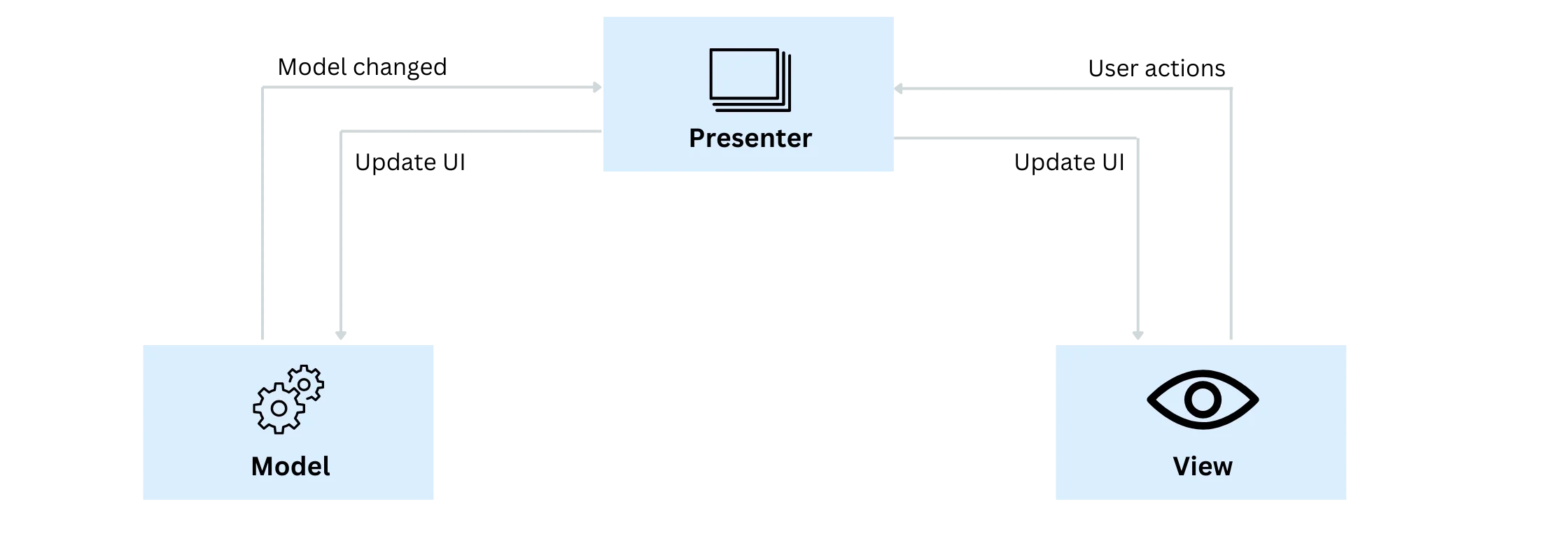
MVP is yet another UI architecture pattern that organizes the presentation layer into Model, View, and Presenter. In MVP, the View is completely passive; it only displays data provided to it. The Presenter takes on a more active role, directly updating the View and handling user interactions. This direct relationship makes the View highly testable, making MVP a good option for apps where thorough software testing is a high priority.
Choosing the Right UI Pattern for Your Mobile App Architecture
Choosing the right UI architecture pattern is essential for building robust and maintainable mobile apps. MVC, MVVM, and MVP each offer different strengths. The best choice depends on your app’s specific needs, like UI complexity and how important testability is. A well-chosen pattern makes development smoother and keeps your app healthy in the long run. Keep in mind that UI architecture is just one part of a complete mobile application architecture, which also includes things like data storage and security. Good planning across all these areas is key to successful mobile app development.
Android mobile app architecture
When considering platform-specific architectures, Android development strongly favors MVVM, particularly with the rise of Jetpack Compose. Google’s Android Architecture Components, including ViewModel, LiveData, and Room, streamline MVVM implementation, and modern Android architectures advocate for a layered approach, separating concerns into UI, optional Domain, and Data layers
iOS mobile app architecture
In iOS, while MVC remains prevalent, MVVM is gaining significant traction, especially with SwiftUI’s declarative UI paradigm, which aligns naturally with MVVM’s data binding principles. The Combine framework and other reactive libraries further support the handling of data streams within MVVM
Key Factors to Consider when Designing Mobile App Architecture
Having learned what a mobile application architecture is all about, it’s time to consider the key factors that influence your architectural decisions. These factors range from technical considerations like developmental frameworks to business-driven concerns like cost and time to market.
Here are 10 key factors to consider:
#1: Target platforms and devices
Your mobile app architecture must support your target platforms (iOS, Android, or both) and the range of devices you plan to support. Consider variations in screen size, processing power, and memory. Supporting a wide range of devices can add complexity, so careful planning is essential.
#2: Development frameworks
Your chosen mobile app programming languages and frameworks (e.g., Swift/SwiftUI, Kotlin/Compose, React Native, Flutter) will significantly influence your architecture. Consider how the language and framework features (e.g., data binding, reactive programming) align with different architectural patterns.
#3: Network conditions
If your app needs to function with limited or intermittent connectivity, your architecture must include offline capabilities, data caching, and efficient synchronization mechanisms.
#4: UI/UX complexity
The complexity of your user interface and navigation will impact your architectural choices. Consider how the architecture supports data binding, custom UI elements, and navigation patterns. A complex UI often benefits from patterns like MVVM, which help manage data flow and UI logic.
#5: Scalability
Plan for growth. Your architecture should be scalable to handle increasing users, data, and traffic without performance degradation. Scalability is essential for long-term success and requires careful consideration of database design, server infrastructure, and application logic.
#6: Maintainability
A well-structured architecture is crucial for long-term maintenance. Prioritize clean code, separation of concerns, and ease of updates and debugging. A maintainable codebase reduces development costs and makes it easier to add new features or fix bugs.
#7: Testability
Thorough testing is essential. Choose a mobile app architecture that facilitates testing, especially unit testing of key components.
#8: Performance
User experience depends on performance. Your mobile application architecture should support efficient data handling, processing, and rendering to ensure a responsive and fast mobile app.
#9: Cost and time to market
Balance your budget and timeline. Consider the development costs and the time required to implement your chosen architecture. There’s often a trade-off between speed of development and the long-term benefits of a great mobile app architecture.
#10: Security
Your architecture must include strong security measures, including authentication, authorization, data encryption, and secure communication. Security should be integrated into the mobile app architecture from the beginning, not added as an afterthought.
Conclusion
A solid mobile app architecture is essential for building successful mobile apps. By carefully considering the layers, patterns, and factors we’ve discussed, you can create a powerful and maintainable mobile app. A well-defined architecture is key to achieving your business goals and delivering a great user experience.
LARION is a trusted partner specializing in helping businesses design and implement robust and scalable mobile app architectures. We understand the complexities of mobile development and can guide you in creating an architecture that aligns with your business goals and technical requirements. Contact us today to discuss your project and discover how we can help you achieve your mobile app development goals.



